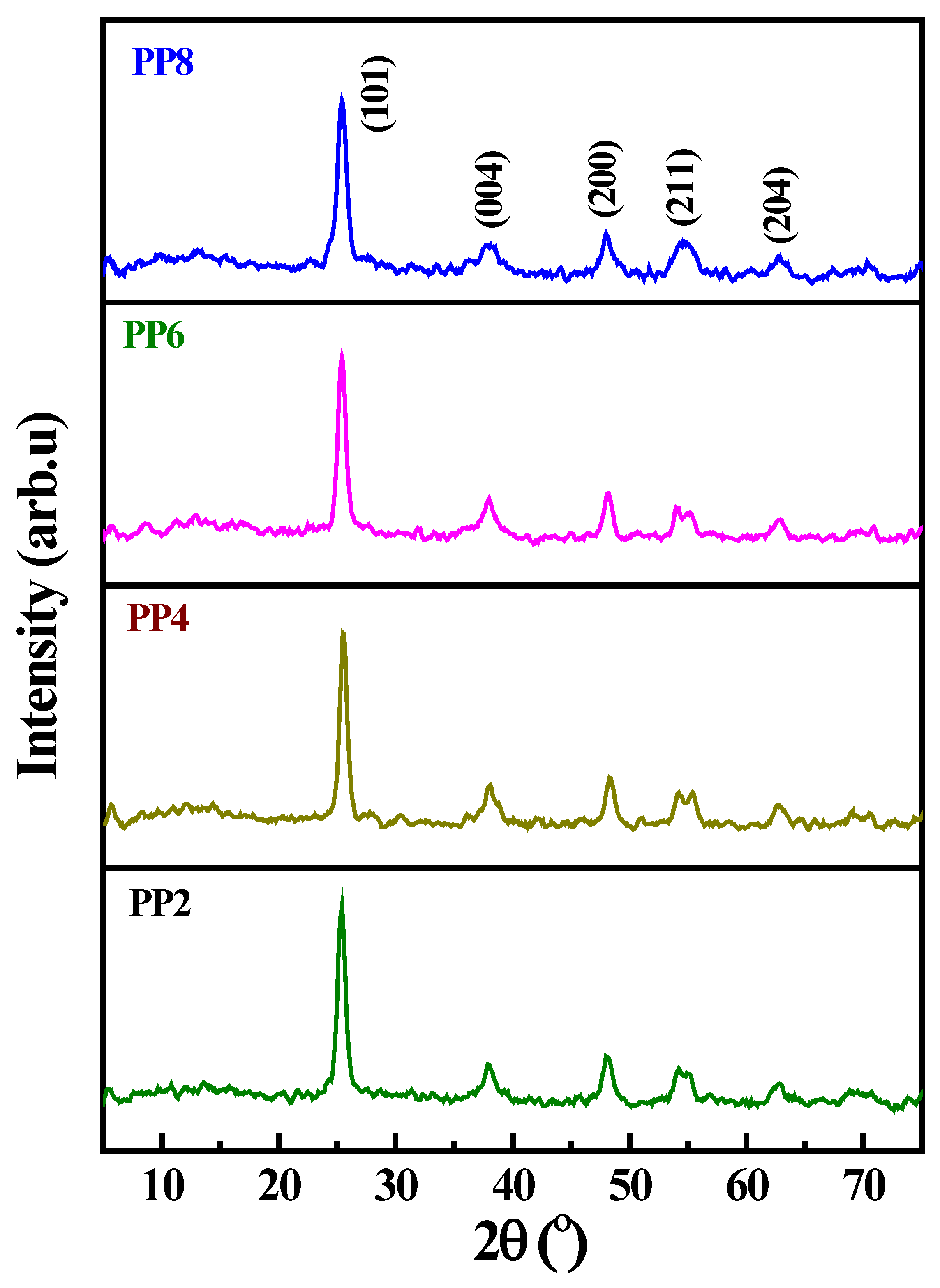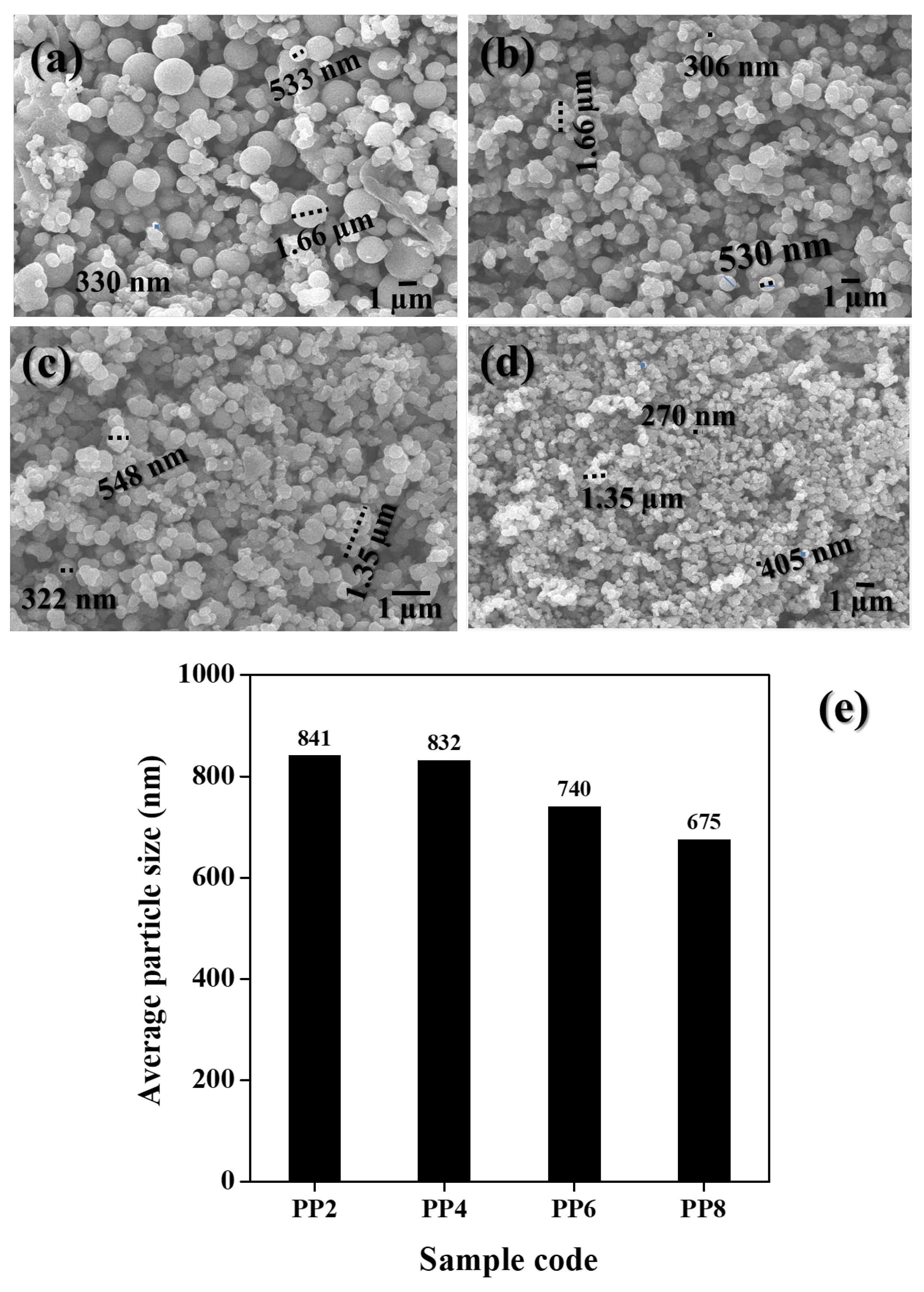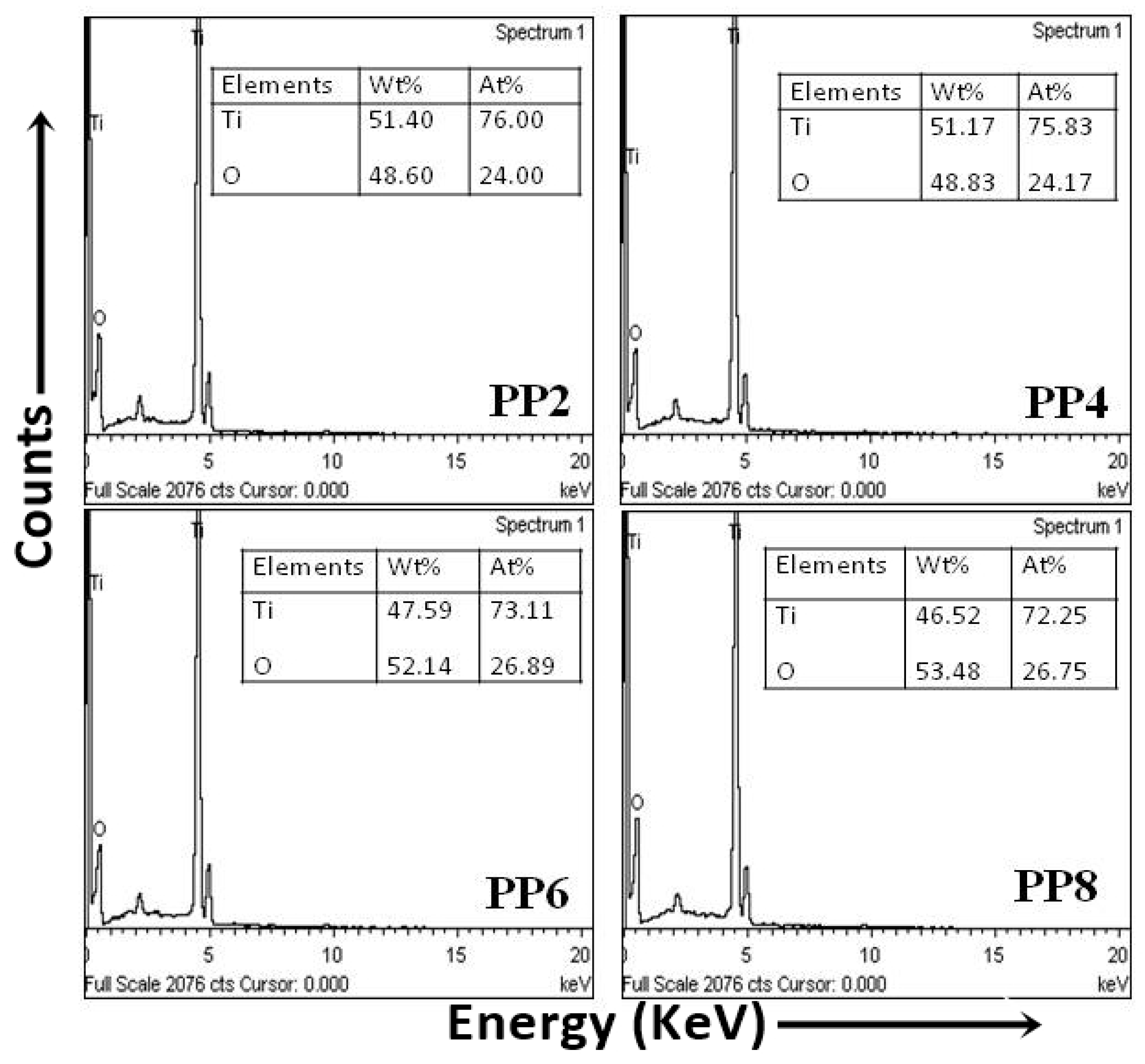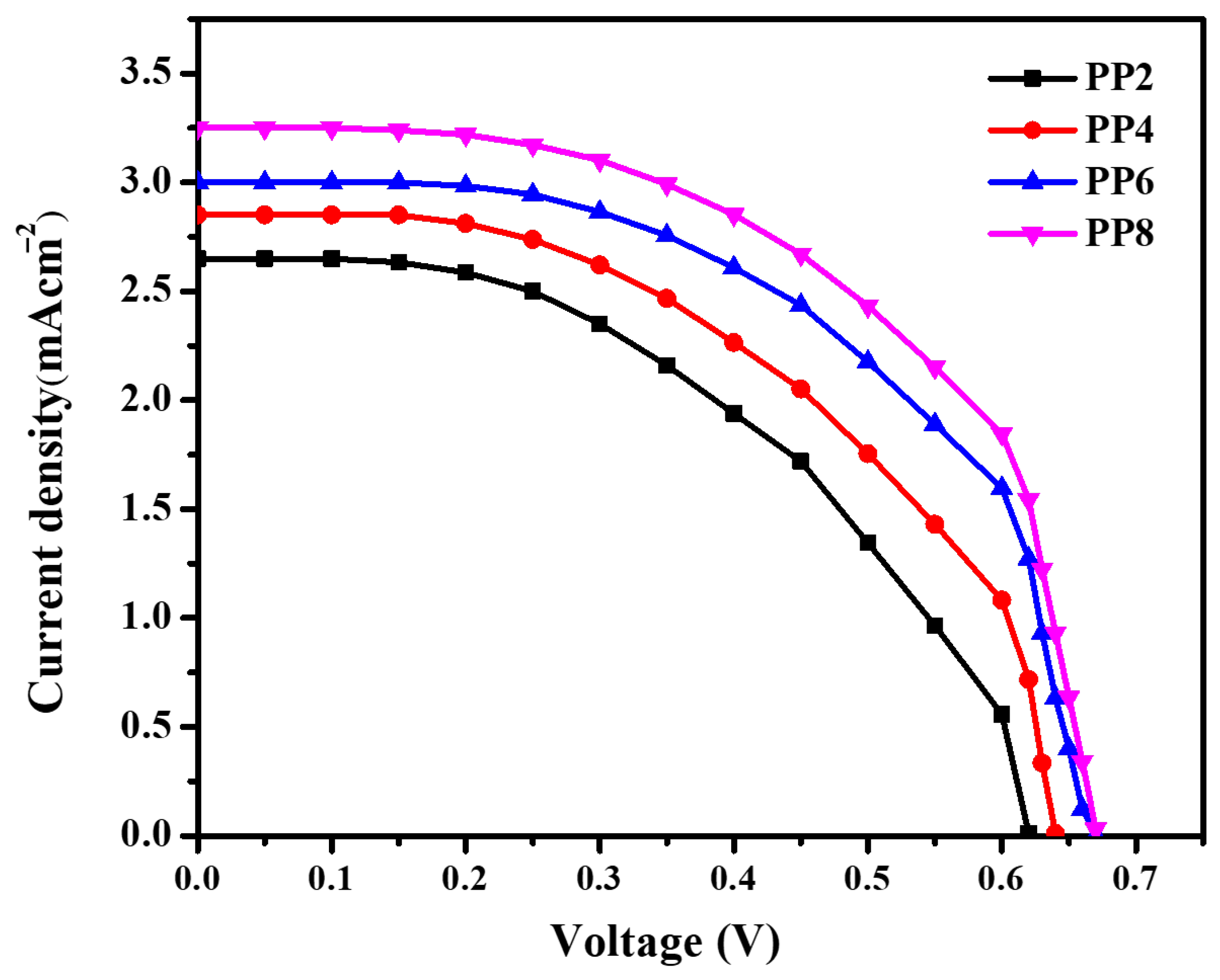Prickly Pear Fruit Extract: Capping Agent for the Sol–Gel Synthesis of Discrete Titanium Dioxide Nanoparticles and Sensitizer for Dye-Sensitized Solar Cell
Abstract
1. Introduction
2. Materials and Methods
2.1. Materials
2.2. Preparation of Prickly Pear Fruit Extract (PPE)
2.3. Prickly Pear Dye Preparation
2.4. Green Sol–Gel Synthesis of TiO2 NPs
2.5. Fabrication of DSSC Using Green Synthesized TiO2 NPs
2.6. Characterization
3. Results and Discussion
| Photo Anode | Dye | Efficiency (η%) | Reference |
|---|---|---|---|
| TiO2 | RB | 0.89 | [44] |
| TiO2 | RB | 0.14 | [45] |
| TiO2 + ZnO | EY | 0.39 | [46] |
| TiO2 | EY | 0.9 | [29] |
| TiO2 | EY | 1.07 | [47] |
| TiO2 | EY | 0.89 | [48] |
| TiO2 | Bromophenol blue | 0.33 | [48] |
| PP8 | RB | 1.16 | This work |
| PP8 | EY | 0.80 | This work |
| PP8 | PPE | 1.40 | This work |
4. Conclusions
Author Contributions
Funding
Institutional Review Board Statement
Informed Consent Statement
Data Availability Statement
Acknowledgments
Conflicts of Interest
References
- Akila, Y.; Muthukumarasamy, N.; Velauthapillai, D. Chapter 5-TiO2-based dye-sensitized solar cells. In Nanomaterials for Solar Cell Applications; Thomas, S., Kalarikkal, N., Wu, J., Sakho, E.H.M., Oluwafemi, S.O., Eds.; Elsevier: Amsterdam, The Netherlands, 2019; pp. 127–144. [Google Scholar] [CrossRef]
- Jiawei, G.; Sumathy, K.; Qiquan, Q.; Zhengping, Z. Reiew on dye–sensitized solar cells (DSSC): Advanced techniques and research trends. Renew. Sustain. Energy Rev. 2017, 68, 234–246. [Google Scholar] [CrossRef]
- Li, R.; Li, C.; Liu, M.; Vivo, P.; Zheng, M.; Dai, Z.; Zhan, J.; He, B.; Li, H.; Yang, W.; et al. Hydrogen-bonded dopant-free hole transport material enables efficient and stable inverted perovskite solar cells. CCS Chem. 2022, 4, 3084–3094. [Google Scholar] [CrossRef]
- Wang, C.; Liu, M.; Rahman, S.; Pekka Pasanen, H.P.; Tian, J.; Li, J.; Deng, Z.; Zhang, H.; Vivo, P. Hydrogen bonding drives the self-assembling of carbazole-based hole-transport material for enhanced efficiency and stability of perovskite solar cells. Nano Energy 2022, 101, 107604. [Google Scholar] [CrossRef]
- Macwan, D.P.; Dave, P.N.; Chaturvedi, S. A review on nano-TiO2 Sol-gel type syntheses and its applications. J. Mater. Sci. 2011, 46, 3669–3686. [Google Scholar] [CrossRef]
- Akpan, U.G.; Hameed, B.H. The advancements in sol-gel method of doped–TiO2 photocatalysts. Appl. Catal. A Gen. 2010, 375, 1–11. [Google Scholar] [CrossRef]
- Galkina, O.L.; Vinogradov, V.V.; Agafonov, A.V.; Vinogradov, A.V. Surfactant-Assisted Sol-Gel Synthesis of TiO2 with Uniform Particle Size Distribution. J. Inorg. Chem. 2011, 8, 108087. [Google Scholar] [CrossRef]
- Babu, N.; Pathak, V.M.; Singh, A.; Navneet, A. Sonchus asper leaves aqueous extract mediated synthesis of Titanium dioxide nanoparticles. Pharma Innov. J. 2019, 8, 817–822. [Google Scholar]
- Nabi, G.; Khalid, N.R.; Tahir, M.B.; Rafique, M.; Rizwan, M.; Hussain, S.; Iqbal, T.; Majid, A. A Review on Novel Eco-Friendly Green Approach to Synthesis TiO2 Nanoparticles Using Different Extracts. J. Inorg. Organomet. Polym. Mater. 2018, 28, 1552–1564. [Google Scholar] [CrossRef]
- Radhika, R.; Venugopal, D.; Jayabal, P.; Saravanakumar, M.; Selvakumar, P. Terminali acatappa and carissacarandas assisted synthesis of TiO2 nanoparticles—A green synthesis approach. Mater. Today Proc. 2021, 45, 2232–2238. [Google Scholar] [CrossRef]
- Ganapathi Rao, K.; Ashok, C.H.; Venkateswara Rao, K.; Shilpa Chakra, C.H.; Tambur, P. Green Synthesis of TiO2 Nanoparticles Using Aloe Vera Extract. Int. J. Adv. Res. Phys. Sci. 2015, 2, 28–34. [Google Scholar]
- Fall, A.; Ngom, I.; Bakayoko, M.; Sylla, N.F.; Mohamed, H.E.; Jadvi, K.; Kaviyarasu, K.; Ngom, B.D. Biosynthesis of TiO2 nanoparticles by using natural extract of Citrus sinensis. Mater. Today Proc. 2021, 36, 349–356. [Google Scholar] [CrossRef]
- Rodríguez-Jiménez, R.A.; Panecatl-Bernal, Y.; Carrillo-López, J.; Méndez-Rojas, M.Á.; Romero-López, A.; Pacio-Castillo, M.; Vivaldo, I.; Morales-Sánchez, A.; Arce, R.D.; Caram, J.; et al. Influence of ethanolic plant extraction morphology and size distribution of sol-gel prepared TiO2 nanoparticles. Chem. Sel. 2021, 6, 3958–3968. [Google Scholar] [CrossRef]
- Richhariya, G.; Kumar, A.; Tekasakul, P. Natural dyes for dye sensitized solar cell: A review. Renew. Sustain. Energy Rev. 2017, 69, 705–718. [Google Scholar] [CrossRef]
- Jamalullail, N.; Mohamad, I.S.; Norizan, M.N.; Baharum, N.A. Short review: Natural pigments photo sensitizer for dye-sensitized solar cell (DSSC). In Proceedings of the 2017 IEEE 15th Student Conference on Research and Development (SCOReD), Wilayah Persekutuan Putrajaya, Malaysia, 13–14 December 2017; pp. 344–349. [Google Scholar] [CrossRef]
- Ananth, S.; Arumanayagam, T.; Vivek, P.; Murugakoothan, P. Direct synthesis of natural dye mixed titanium dioxide nanoparticles sol-gel method for dye sensitized solar cell applications. Optik 2014, 125, 495–498. [Google Scholar] [CrossRef]
- Ananth, S.; Vivek, P.; Arumanayagam, T.; Murugakoothan, P. Pre dye treated titanium dioxide nanoparticles synthesized by modified sol-gel method for efficient dye-sensitized solar cells. Appl. Phys. A 2015, 119, 989–995. [Google Scholar] [CrossRef]
- Swathi, S.; Kulkarani, S.; Hussaini, S.; Gajanan Bodkhe, A. Natural hibiscus dye and synthetic organic eosin dye sensitized solar cell using titanium dioxide nanoparticles photo anode: Comparative study. Surf. Rev. Lett. 2019, 26, 1850164. [Google Scholar] [CrossRef]
- Sanjay, P.; Deep, K.; Mdhavan, J.; Senthil, S. Performance of TiO2 based sensitized solar cells fabricated with dye extracted from leaves of peltophorum pterocarpum and acalypha amentacea as sensitizer. Mater. Lett. 2018, 219, 158–162. [Google Scholar] [CrossRef]
- Ananth, S.; Vivek, P.; Saravana Kumar, G.; Murugakoothan, P. Performance of caessalpinia sappan heartwoodextract as photo sensitizer for dye sensitized solar cells. Spectrochim. Acta Part A Mol. Bimolecular Spectrosc. 2015, 137, 345–350. [Google Scholar] [CrossRef]
- Prabu, K.M.; Anbarasan, P.M. Improved performance of natural dye sensitized solar cells (NDSSCS) using ZnO doped TiO2 nanoparticles by sol-gel method. Int. J. Sci. Res. 2014, 3, 1740–1747. [Google Scholar]
- Iswariya, S.; Clara Dhanemozhi, A.; Yugamica, S. Synthesis and characterization of dye sensitized solar cell using fruit extracts. Int. Res. J. Eng. Technol. (IRJET) 2017, 4, 277–285, ISSN 2395-0056. [Google Scholar]
- Nandarapu, P.; Reshma, K.; Ganapathy, V.; Kovendhan, M.; Paul Joseph, D. Prickly pear fruit extract as photosensitizer for dye-sensitized solar cell Spectrochim. Acta Part A Mol. Biomol. Spectrosc. 2020, 228, 117686. [Google Scholar] [CrossRef]
- Giuseppe, C.; Gaetano Di, M.; Silvia, C.; Stefano, C.; Roberto, A.; Aldo Di, C.; Carlo Alberto, B. Efficient Dye-Sensitized Solar Cells Using Red Turnip and Purple Wild Sicilian Prickly Pear Fruits. Int. J. Mol. Sci. 2010, 11, 254–267. [Google Scholar] [CrossRef]
- Kenneth, O.; Liliya, F.; Paul, F. Preparation and performance of prickly pear (Opuntia phaeacantha) and mulberry (Morus rubra) dye-sensitized solar cells. Sol. Energy 2020, 208, 312–320. [Google Scholar] [CrossRef]
- Prabu, K.M.; Anbarasan, P.M.; Ranjitha, S. Natural Dye-Sensitized Solar Cells (NDSSCs) from Opuntia Prickly Pear Dye Using ZnO Doped TiO2 Nanoparticles by Sol Gel Method. Int. J. Eng. Res. Appl. 2014, 4, 2248–9622. [Google Scholar]
- Noureddine, B.; Khalid, O.; Mohamed, A.; Mohammed, M. Dried prickly pear cactus (Opuntia ficus indica) cladodes as a low-cost andeco-friendly biosorbent for dyes removal from aqueous solutions. J. Taiwan Inst. Chem. Eng. 2013, 44, 52–60. [Google Scholar] [CrossRef]
- Rauf, M.A.; Graham, J.P.; Bukallah, S.B.; Al-Saedi, M.A.S. Solvatochromic behavior on the absorption and fluorescence spectra of Rose Bengal dye in various solvents. Spectrochim. Acta Part A 2009, 72, 133–137. [Google Scholar] [CrossRef]
- Zhang, F.; Shi, F.; Ma, W.; Gao, F.; Jiao, Y.; Li, H.; Wang, J.; Shan, X.; Lu, X.; Meng, S. Controlling Adsorption Structure of Eosin Y Dye on Nanocrystalline TiO2 Films for Improved Photovoltaic Performances. J. Phys. Chem. C 2013, 117, 14659−14666. [Google Scholar] [CrossRef]
- Chen, J.; Zhang, L. NH4Cl-assisted low temperature synthesis of anatase TiO2 nanostructures from Ti powder. Mater. Lett. 2009, 63, 1797–1799. [Google Scholar] [CrossRef]
- Laisney, J.; Rosset, A.; Bartolomei, V.; Predoi, D.; Truffier-Boutry, D.; Artous, S.; Bergé, V.; Brochard, G.; Michaud-Soret, I. TiO2 nanoparticles coated with bio-inspired ligands for the safer-by-design development of photocatalytic paints. Environ. Sci. Nano 2021, 8, 297–310. [Google Scholar] [CrossRef]
- Hargreaves, J.S.J. Some considerations related to the use of the Scherrer equation in powder X-ray diffraction as applied to heterogeneous catalysts. Catal. Struct. React. 2016, 2, 33–37. [Google Scholar] [CrossRef]
- Nandhakumar, E.; Priya, P.; Selvakumar, P.; Vaishnavi, E.; Sasikumar, A.; Senthilkumar, N. One step hydrothermal green approach of CuO/Ag nanocomposites: Analysis of structural, biological activities. Mater. Res. Express 2019, 6, 95036. [Google Scholar] [CrossRef]
- Pitchaiya, S.; Eswaramoorthy, N.; Natarajan, M.; Santhanam, A.; Asokan, V.; Ramakrishnan, V.M.; Rangasamy, B.; Sundaram, S.; Ravirajan, P.; Velauthapillai, D. Perovskite solar cells: A porous graphitic carbon-based hole transporter/counter electrode material extracted from an invasive plant species eichhornia crassipes. Sci. Rep. 2020, 10, 6835. [Google Scholar] [CrossRef] [PubMed]
- Sundaram, M.; Kalpana, S.; Sivaganesan, V.; Nandhakumar, E. Studies on the catalytic activity of CuO/TiO2/ZnO ternary nanocomposites prepared via one step hydrothermal green approach. Mater. Res. Express 2019, 6, 125043. [Google Scholar] [CrossRef]
- Heiba, Z.K.; Mohamed, M.B.; Badawi, A. Structural and Optical Characteristic of Cu-Doped TiO2 Thin Film. J. Inorg. Organomet. Polym. 2022, 32, 2853–2862. [Google Scholar] [CrossRef]
- Kwak, C.-H.; Im, U.-S.; Seo, S.-W.; Kim, M.-I.; Huh, Y.-S.; Im, J.-S. Effects of carbon doping on TiO2 for enhanced visible light-driven NO sensing performance. Mater. Lett. 2021, 288, 129313. [Google Scholar] [CrossRef]
- Ramanarayanan, R.; Nijisha, P.; Niveditha, C.V.; Sindhu, S. Natural dyes from red amaranth leaves as light-harvesting pigments for dye-sensitized solar cells. Mater. Res. Bull. 2017, 90, 156–161. [Google Scholar] [CrossRef]
- Calogero, G.; Di Marco, G.; Caramori, S.; Cazzanti, S.; Argazzi, R.; Bignozzi, C.A. Natural dye sensitizers for photoelectrochemical cells. Energy Environ. Sci. 2009, 2, 1162–1172. [Google Scholar] [CrossRef]
- Dai, Q.; Rabani, J. Photosensitization of nanocrystalline TiO2 films by anthocyanin dyes. J. Photochem. Photobiol. A Chem. 2002, 148, 17–24. [Google Scholar] [CrossRef]
- Subalakshmi, K.; Senthilselvan, J.; Kumar, K.A.; Kumar, S.; Pandurangan, A. Solvothermal synthesis of hexagonal pyramidal and bifrustum shaped ZnO nanocrystals: Natural betacyanin dye and organic Eosin Y dye sensitized DSSC efficiency, electron transport, recombination dynamics and solar photodegradation investigations. J. Mater. Sci. Mater. Electron. 2017, 28, 15565–15595. [Google Scholar] [CrossRef]
- Chien, C.Y.; Hsu, B.D. Optimization of the dye-sensitized solar cell with anthocyanin as photosensitizer. Sol. Energy 2013, 98, 203–211. [Google Scholar] [CrossRef]
- Barichello, J.; Mariani, P.; Matteocci, F.; Vesce, L.; Reale, A.; Di Carlo, A.; Lanza, M.; Di Marco, G.; Polizzi, S.; Calogero, G. The Golden Fig: A Plasmonic Effect Study of Organic-Based Solar Cells. Nanomaterials 2022, 12, 267. [Google Scholar] [CrossRef] [PubMed]
- Jambure, S.B.; Gund, G.S.; Dubal, D.P.; Shinde, S.S.; Lokhande, C.D. Cost effective facile synthesis of TiO2 nanograins for flexible DSSC application using rose bengal dye. Electron. Mater. Lett. 2014, 10, 943–950. [Google Scholar] [CrossRef]
- Jimmy, M.J.; Harun, A.M.; Rahman, M.Y.A.; Ludin, N.A. Comparative study of dye sensitized solar cell utilizing seaweed and rose Bengal sensitizer: Influence of dye concentration. Int. J. Electrochem. Sci. 2020, 15, 3219–3231. [Google Scholar] [CrossRef]
- Manikandan, V.S.; Palai, A.K.; Mohanty, S.; Nayak, S.K. Eosin-Y sensitized core-shell TiO2-ZnO nano-structured photoanodes for dye-sensitized solar cell applications. J. Photochem. Photobiol. B Biol. 2018, 183, 397–404. [Google Scholar] [CrossRef]
- Yildiz, Z.K.; Atilgan, A.; Atli, A.; Özel, K.; Altinkaya, C.; Yildiz, A. Enhancement of efficiency of natural and organic dye sensitized solar cells using thin film TiO2 photoanodes fabricated by spin-coating. J. Photochem. Photobiol. A Chem. 2019, 368, 23–29. [Google Scholar] [CrossRef]
- Richhariya, G.; Kumar, A. Performance evaluation of mixed synthetic organic dye as sensitizer based dye sensitized solar cell. Opt. Mater. 2021, 111, 110658. [Google Scholar] [CrossRef]









| Sample Codes | Dye | Voc (V) | Jsc (mA cm–2) | FF% | η % |
|---|---|---|---|---|---|
| PP2 | RB | 0.61 | 2.64 | 0.47 | 0.75 |
| PP4 | RB | 0.63 | 2.85 | 0.49 | 0.87 |
| PP6 | RB | 0.66 | 2.99 | 0.53 | 1.04 |
| PP8 | RB | 0.66 | 3.22 | 0.55 | 1.16 |
| PP8 | EY | 0.64 | 2.85 | 0.48 | 0.80 |
| PP8 | PP | 0.66 | 3.49 | 0.61 | 1.40 |
Disclaimer/Publisher’s Note: The statements, opinions and data contained in all publications are solely those of the individual author(s) and contributor(s) and not of MDPI and/or the editor(s). MDPI and/or the editor(s) disclaim responsibility for any injury to people or property resulting from any ideas, methods, instructions or products referred to in the content. |
© 2023 by the authors. Licensee MDPI, Basel, Switzerland. This article is an open access article distributed under the terms and conditions of the Creative Commons Attribution (CC BY) license (https://creativecommons.org/licenses/by/4.0/).
Share and Cite
Rajendhiran, R.; Atchudan, R.; Palanisamy, J.; Balasankar, A.; Oh, T.H.; Deivasigamani, V.; Ramasundaram, S. Prickly Pear Fruit Extract: Capping Agent for the Sol–Gel Synthesis of Discrete Titanium Dioxide Nanoparticles and Sensitizer for Dye-Sensitized Solar Cell. Coatings 2023, 13, 579. https://doi.org/10.3390/coatings13030579
Rajendhiran R, Atchudan R, Palanisamy J, Balasankar A, Oh TH, Deivasigamani V, Ramasundaram S. Prickly Pear Fruit Extract: Capping Agent for the Sol–Gel Synthesis of Discrete Titanium Dioxide Nanoparticles and Sensitizer for Dye-Sensitized Solar Cell. Coatings. 2023; 13(3):579. https://doi.org/10.3390/coatings13030579
Chicago/Turabian StyleRajendhiran, Radhika, Raji Atchudan, Jayabal Palanisamy, Athinarayanan Balasankar, Tae Hwan Oh, Venugopal Deivasigamani, and Subramaniyan Ramasundaram. 2023. "Prickly Pear Fruit Extract: Capping Agent for the Sol–Gel Synthesis of Discrete Titanium Dioxide Nanoparticles and Sensitizer for Dye-Sensitized Solar Cell" Coatings 13, no. 3: 579. https://doi.org/10.3390/coatings13030579
APA StyleRajendhiran, R., Atchudan, R., Palanisamy, J., Balasankar, A., Oh, T. H., Deivasigamani, V., & Ramasundaram, S. (2023). Prickly Pear Fruit Extract: Capping Agent for the Sol–Gel Synthesis of Discrete Titanium Dioxide Nanoparticles and Sensitizer for Dye-Sensitized Solar Cell. Coatings, 13(3), 579. https://doi.org/10.3390/coatings13030579








